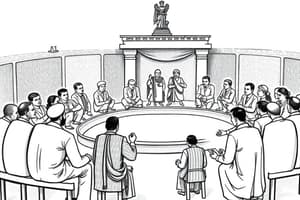Podcast
Questions and Answers
Who was the principal architect of the Indian Constitution?
Who was the principal architect of the Indian Constitution?
- Jawaharlal Nehru
- Mahatma Gandhi
- Sardar Vallabhbhai Patel
- B.R. Ambedkar (correct)
What is the highest number of amendments made to the Indian Constitution as of 2023?
What is the highest number of amendments made to the Indian Constitution as of 2023?
- 75
- 100
- 105 (correct)
- 50
Which articles in the Indian Constitution guarantee Fundamental Rights?
Which articles in the Indian Constitution guarantee Fundamental Rights?
- 12-35 (correct)
- 60-75
- 40-50
- 1-10
Which amendment introduced the words 'socialist' and 'secular' into the Preamble of the Constitution?
Which amendment introduced the words 'socialist' and 'secular' into the Preamble of the Constitution?
What is the primary feature of the Indian Constitution's federal structure?
What is the primary feature of the Indian Constitution's federal structure?
Which body does the Judiciary in India interpret the Constitution?
Which body does the Judiciary in India interpret the Constitution?
What is the significance of the Directive Principles of State Policy?
What is the significance of the Directive Principles of State Policy?
What concept ensures that no individual is above the law in India?
What concept ensures that no individual is above the law in India?
Flashcards are hidden until you start studying
Study Notes
Overview
- The Indian Constitution is the supreme law of India.
- It establishes the framework for the political principles, procedures, rights, and duties of Indian citizens.
Historical Background
- Adopted on January 26, 1950.
- Drafted by the Constituent Assembly, led by Dr. B.R. Ambedkar as the principal architect.
- Influenced by various sources, including the Government of India Act 1935, British constitutional law, and the U.S. Constitution.
Structure
- Parts: The Constitution has 22 parts divided into various articles.
- Schedules: There are 12 schedules that list various details like the allocation of powers, official languages, and more.
- Amendments: The Constitution has been amended over 100 times since its enactment, with the 105th amendment being the latest as of 2023.
Key Features
- Federal Structure: Division of powers between the central government and state governments.
- Parliamentary System: India follows a parliamentary system of governance.
- Fundamental Rights: Articles 12-35 guarantee individual rights, including the right to equality, freedom of speech, and protection against discrimination.
- Directive Principles of State Policy: Articles 36-51 guide the state in policy-making aimed at social and economic justice.
- Fundamental Duties: Article 51A enumerates civic duties of citizens.
Major Principles
- Rule of Law: Ensures equality before the law and no one is above the law.
- Secular State: The Constitution guarantees freedom of religion and prohibits discrimination on religious grounds.
- Social Justice: Focuses on uplifting marginalized sections and promoting welfare.
Key Institutions
- President: Head of the state, with various powers and responsibilities.
- Parliament: Bicameral legislature consisting of the Lok Sabha (House of the People) and Rajya Sabha (Council of States).
- Judiciary: Independent judiciary with the Supreme Court at the apex, ensuring the Constitution's interpretation and upholding of rights.
Important Amendments
- First Amendment (1951): Introduced restrictions on freedom of speech and expression.
- 42nd Amendment (1976): Made significant changes during the Emergency, including the addition of the words "socialist" and "secular" to the Preamble.
- 73rd and 74th Amendments (1992): Strengthened local self-governance through Panchayati Raj institutions.
Conclusion
- The Indian Constitution is a living document that embodies the aspirations and values of its people.
- It provides a framework for governance, rights, and responsibilities, ensuring democracy and justice in the nation.
Indian Constitution Overview
- Supreme law of India establishes framework for political principles, procedures, rights, and duties of Indian citizens.
- Adopted on January 26, 1950.
Historical Background
- Drafted by the Constituent Assembly, led by Dr. B.R. Ambedkar as the principal architect.
- Influenced by various sources, including the Government of India Act 1935, British constitutional law, and the U.S. Constitution.
Structure
- Composed of 22 parts divided into various articles.
- Contains 12 schedules that outline allocation of powers, official languages, and other details.
- Amended over 100 times since its enactment, with the 105th amendment being the latest as of 2023.
Key Features
- Divides powers between the central government and state governments, creating a federal structure.
- Implements a parliamentary system of governance.
- Guarantees individual rights in Articles 12-35, including the right to equality, freedom of speech, and protection against discrimination.
- Guides the state in policy-making aimed at social and economic justice through Articles 36-51 (Directive Principles of State Policy).
- Outlines civic duties of citizens in Article 51A (Fundamental Duties).
Major Principles
- Enforces the rule of law, ensuring equality before the law and no one is above the law.
- Establishes India as a secular state, guaranteeing freedom of religion and prohibiting religious discrimination.
- Focuses on uplifting marginalized sections and promoting welfare through social justice principles.
Key Institutions
- President: Head of state with various powers and responsibilities.
- Parliament: Bicameral legislature consisting of the Lok Sabha (House of the People) and Rajya Sabha (Council of States).
- Judiciary: Independent judiciary with the Supreme Court as the apex court, responsible for interpreting the Constitution and upholding rights.
Important Amendments
- First Amendment (1951): Introduced restrictions on freedom of speech and expression.
- 42nd Amendment (1976): Implemented significant changes during the Emergency, including adding "socialist" and "secular" to the Preamble.
- 73rd and 74th Amendments (1992): Strengthened local self-governance through Panchayati Raj institutions.
Conclusion
- The Indian Constitution is a living document that reflects the aspirations and values of its people.
- It provides a framework for governance, rights, and responsibilities, ensuring democracy and justice in the nation.
Studying That Suits You
Use AI to generate personalized quizzes and flashcards to suit your learning preferences.



